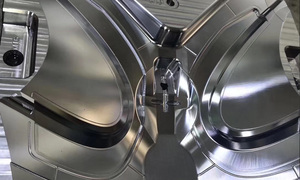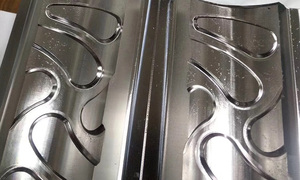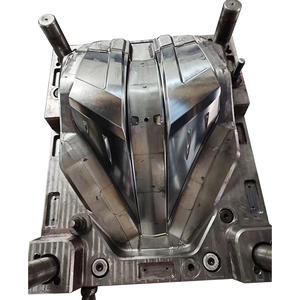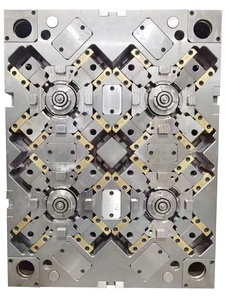
All categories
Featured selections
Trade Assurance
Buyer Central
Help Center
Get the app
Become a supplier

(234 products available)





















The plastic car bumper mould can be fabricated from various materials, each offering distinct advantages in terms of durability, cost, and ease of machining.
Steel: Steel remains one of the most widely used materials for plastic car bumper moulds. In its case, due to its durability, strength, and high resistance to wear, it's ideal for producing parts with long-term production in mind. Steel moulds, however, provide excellent dimensional stability and can withstand the high temperatures required for injecting plastics, thus making them suitable for diverse applications.
Aluminum: Although not as resilient as steel, aluminum is considerably lighter, which will reduce the overall weight of the moulding equipment. Also, its exceptional thermal conductivity makes it possible for heat to be transferred quickly during the injection process. Aluminum moulds are occasionally used in production runs when the bumper components have to be fabricated in low to moderate quantities.
Stainless steel: Stainless steel is employed for plastic car bumper moulds in cases where corrosion resistance is of critical importance. Its uses are in tropical regions, in vehicles exposed to salty water, or in areas with extreme weathering conditions. Though ss steel is more expensive and not as easy to work with as normal steel, its longevity in corrosive situations is incomparable.
Tool steel: Tool steel combines the best qualities of both worlds, wear resistance, and toughness. Its classification also makes it suitable for high precision requirements in moulding car bumpers. Tool steel is enough for the production of more૦ complex moulds that have frequent use. This includes: flip car moulds and sports car moulds.
Plastics reinforced with composites: Moulds made from these plastics incorporate materials such as carbon fibers or glass to increase rigidity in the plastics. They are used in producing lightweight yet highly durable bumper components. Composite materials present advanced moulds that offer better performance and potentially lower weight for car bumpers.
Each manufacturing material of moulds brings its own unique benefits depending on factors such as production volumes, the complexity of the design, and the environment in which the end product will be used. Selecting the most appropriate material is therefore critical for ensuring the moulds are efficient and reliable.
Several processes work together to create a functional and reliable mould for the plastic car bumper. Each of these processes plays a critical role in ensuring the final product meets the required specifications and quality standards.
Design and CAD modelling: The bumper mould is designed using computer-aided design (CAD) software, which allows for precise modelling of the bumper's shape and features. This design phase includes considerations for the mould's surface finish, texture, and any other aesthetic or functional elements of the bumper. The bumper mould design also entails the incorporation of various engineering has features that promote the planned plastic car parts to be produced. These include:Deslin car parts and convertible car parts.
Mould manufacturing: The bumper mould itself can be constructed from various materials like steel, aluminium, or composite materials. These materials are chosen based on their durability, heat resistance, and compatibility with the type of plastic being used. The mould exterior is machined to form the cavity and core, which are the two foremost parts that create the shape of the bumper.
Injection moulding process: In this process, the chosen plastic material, usually in the form of pellets, is heated until it becomes molten. It is then injected at high pressure into the mould cavity. The high pressure helps ensure that the molten plastic fills all areas of the mould, capturing even the fine details. The plastic used is often ABS (Acrylonitrile Butadiene Styrene), polypropylene, or polyethylene, which are lightweight, durable, and easy to mould. The plastic materials are heated in an injection barrel and liquefied, while being stirred that will homogenize the materials. This prepares the material so that it can fill the mould uniformly.
Cooling and solidification: Once the plastic is injected, the mould is cooled to allow the plastic to solidify into the shape of the bumper. This usually takes several minutes, depending on the size and complexity of the part. The mould is additionally cooled using a system of water channels that are integrated into the mould design. This is to promote the effective beat exchange with water and temperature control. The plastic material generally cools from the outer regions to the inner regions so that it sets into the mould shape, unlike the liquid state.
Demoulding: After the plastic has fully cooled and solidified, the mould is opened to release the new plastic car bumper part. This process can be done manually or using automated machinery, depending on the scale of production. There might also be demoulding aids, such as ejector pins, that help push the moulded bumper out without damaging it.
Post-processing and inspection: The moulded plastic bumper may undergo post-processing steps like trimming excess plastic, surface finishing, and quality inspection. This inspection looks for defects such as air bubbles, incomplete filling, or surface imperfections. Some common features of post-processing include: Surface treatment and quality checks on the bumper moulds are carried out to remove any extra plastic remnants or to finish the surface for aesthetic or functional reasons.
These processes focus on creating a plastic car bumper mould that accurately reflects the design specifications and quality required for automotive applications. Understanding each step is crucial for optimising production and ensuring consistent results.
A plastic car bumper mould is integral to the automotive industry, serving a range of practical and aesthetic functions. Its versatility in materials and design makes it suitable for multiple applications.
Cosmetic purposes: By offering different styles, colours, and textures, plastic bumper moulds give car manufacturers the freedom to create visually appealing designs that best complement the model of the car. This can include sleek, modern aesthetics or rugged off-road looks. The bumper moulds can also incorporate design elements that match current trend configurations and brand identities. For example, custom logo placements or unique colour accents serving as a reason for the car's overall look.
Safety Features: Many modern bumpers have integrated safety features like sensors, cameras, and reinforcement zones. These components work with the moulding to improve safety during accidents., reducing impact on both the vehicle occupants and other road users. In his instances, bumpers made from composite materials have progressive energy absorption capabilities. This aids in the reduction of collision forces and thus has an added benefit of increasing safety.
Aerodynamic efficiency: Car bumper moulds are designed with aerodynamic features that will reduce air resistance, thus improving fuel efficiency. This reduction also promotes the vehicle's overall performance by decreasing drag, especially at higher speeds. In electric vehicles, the aerodynamic bumper shape plays a key role in maximising battery range by minimising energy consumption.
Brand differentiation: Car manufacturers use bumper moulds to develop distinctive branding, thus enabling consumers to easily identify different car models, therefore, giving the vehicle a unique aesthetic appeal. This also includes the implementation of custom shapes or design details that are characteristic of a specific brand. Design elements such as colour, shape, and texture reflect the manufacturer's design language, pushing brand recognition to a new level.
Environmentally friendly plastic bumpers: Most bumpers are today made from materials such as polypropylene and polyethylene, which are recycleable plastics. Therefore, at the end of the bumper's lifecycle in a vehicle, it can be recycled into new products, thus promoting sustainability and waste reduction. Some advanced moulds may even incorporate bioplastics sourced from renewable materials like corn starch, boosting the ecosystem.
Ease of repair and replacement: Plastic bumpers are easier to repair or replace in case of damage, such as dents or minor collisions. Moulded plastic can be heated and reshaped or replaced economically, providing functionality without exorbitant expenses. This practicality extends to the daily use and total cost of vehicle ownership.
All these functions demonstrate the essential role plastic car bumper moulds play in modern automotive design, contributing to safety, functionality, aesthetics, and environmental sustainability.
Several key factors should be considered when selecting a mould to make plastic car bumper components.
Material selection: The material used for the mould will determine, to a large extent, how durable and what temperatures the mould can endure. The common materials available during plastic car bumper mould construction are steel, aluminium, and composite materials. They all have different properties, so to speak, with steel being used primarily in robust moulds to be used for a very long time, while aluminium will be much lighter and used for injection of various plasticky in low to moderate quantities.
Mould design and complexity: The design of the car bumper mould should resemble the intended bumper design in every aspect. CAD software can assist in the crafting of an accurate mould. The complexity of the bumper's design will also directly affect the type of mould to be used. Therefore, more complex, intricately designed bumpers will want to use more sophisticated moulds in turn, possibly with additional features like inserts or multiple cavities.
Bumper material compatibility: Different plastic materials have particular heat and chemical properties substantially required during the injection phase. Therefore, the bumper mould material has to be compatible with the plastic material to be used in manufacturing the car bumper. Design the mould of steel if using high-heat plastics and aluminium for low heat, high crash volumes of plasticky.
Production volume: Production volumes or numbers usually determine the type of mould to be used. For a one-off or low-volume production, lighter, aluminium plasticky moulds are often used, but for high-volume production, steel moulds are practically employed because they are durable, can suffer wear and tear, and economically speaking, they are savvy for long-term use.
Maintenance and durability: It is necessary to assess the mould's lifetime, as this plays a crucial role in making it effective over time. Likewise, just as important, are the maintenance requirements of the mould. Cooling systems integrated into the mould can allow the mould to maintain an appropriate temperature during extremely long production runs.
Cost considerations: The cost of the mould is indeed an essential factor depending on budget constraints and the projected car bumpers' production volume. While steel moulds might be considered expensive at first, they will be cost-effective in the long run if the production were to continue for quite a while.
Considering all these factors in tandem will aid in deciding the best mould for producing plastic car bumpers in a wide variety of applications.
A1: The moulding process actually allows plastic to be formed into energy-absorbing structures. This helps deflect impact forces during minor collisions, maximising user safety in such events.
A2: This is due to their ideal mechanical properties, low density, affordable cost, and resistance to many chemical inputs. Also, polypropylene, polyethylene, and acrylonitrile butadiene styrene are the go-to plastics for this process.
A3: Stronger materials make premium-quality bumpers, resistance to wear and tear, and more able to endure corrosion. Injection mould steel is suitable for use with high-temperature plastics.
A4: Yes. Most modern plastic car bumpers incorporate recyclable materials, thus lessening the ecological footprint of the automotive industry. Some manufacturers are now using a bioplastic sourced from corn starch as the first plastic to further enhance environmental friendliness.
A5: Regular inspection and cleaning, plus prompt repair of worn or damaged components, ensure the moulds reliably produce quality bumpers. Proper cooling system care is vital for efficient mould operation.